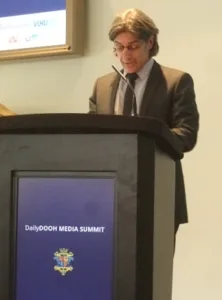Smart cities are a big topic in the DOOH industry, but no-one is very clear on the meaning of the phrase. Albert Asséraf of JCDecaux noted that there are more than 220 million search results for these terms on Google! Some of the areas that Asséraf believes should be included in the definition are ‘Economy’, ‘Mobility’, ‘Governance’ and ‘Living’.
The world is moving towards becoming more and more urbanised. More than half of the global population now lives in cities, forecast to rise to 65% by 2040. There is competition between cities to attract companies, culture, events and people.
JCDecaux is a major smart city player, through its street furniture portfolio. Asséraf gave examples, which include the Paris bus shelters (Display Monitor Vol 21 No 3); 50 free Wi-Fi hotspots built into street furniture in Düsseldorf; and a rollout of 200 4G ‘small cells’ in Amsterdam street furniture. The installation of these cells, through partnerships with Huawei and Alcatel-Lucent, is currently ongoing.
Asséraf showed a video of a concept bus shelter, with a 72″ screen for advertising and a 32″ screen for local wayfinding. It would also offer Wi-Fi, mobile charging points and an audio announcement of bus times.
Speaking about DOOH today, Asséraf showed two videos: one was about JCDecaux’s street furniture installations in Paris’ La Défense business district (Display Monitor Vol 19 No 46), which saw 111 static billboards and 50 digital screens rolled out. The other video used footage from 1947, predicting ‘pocket TVs’ – which bore a striking similarity to smartphones!
“DOOH is now the fifth screen of our life, and it will get more and more attractive”, was the conclusion of the talk.

